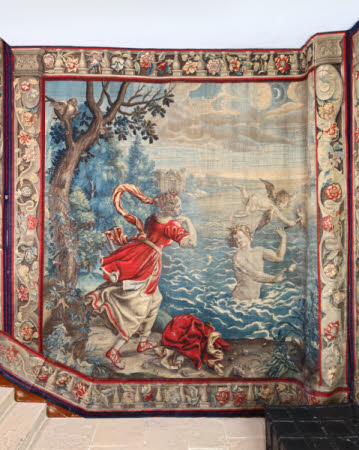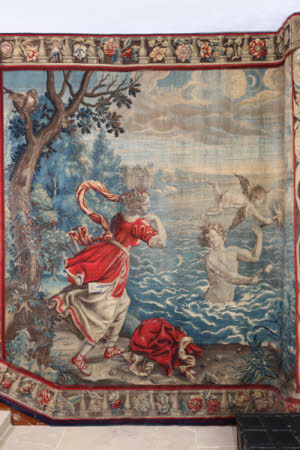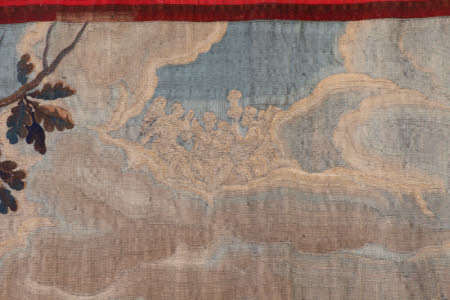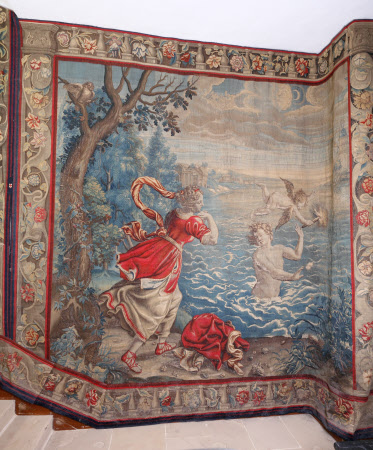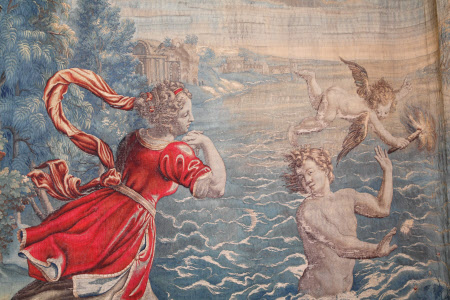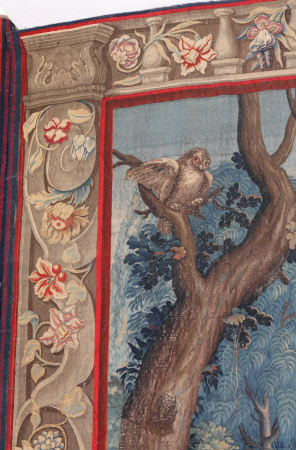Night Swim
Mortlake Tapestry Manufactory
Category
Tapestries
Date
circa 1648 - circa 1660
Materials
Tapestry, wool and silk, 6 warps per cm
Measurements
3.8 m (H); 3.8 m (W)
Place of origin
London
Order this imageCollection
Hardwick Hall, Derbyshire
NT 1129507.4
Summary
The naked Leander stands on the sea bed near the shore waving goodbye to his sister Hermione. Leander's body is visible above the water from the lower abdomen. Hermione in a white dress, red tunic and red sandals clasps her hands in anguish. Cupid above Leander's head holds a lighted torch and points towards Hero's Tower. On the sea shore by Hermione lie Leander's clothes. Above Hermione's head are buildings probably representing Abydos. On the oak tree to the left of Hermione sits an owl. The scene is night and a crescent moon in the right hand corner of the sky is reflected in the water between Hermione's elbow and Leander's shoulder. The upper and left hand borders are integral. A small triangular section has been cut off at the lower left corner to fit the sloping staircase wall. The right hand border has been cut off and sewn back on again. The lower border has also been cut off and sewn back on in three sections going at a cant at the lower left corner. The left edge of the tapestry has been sewn together with the right edge of the tapestry the Arrival of Leander at Hero's Tower [1129507.3].
Full description
‘Night Swim’ is the fourth in the Hardwick set, fifth in the set as designed by Mortlake. This is the calm before the storm which killed poor Leander: Off went his silken robe, and in he leapt; Whom the kinde waves so licorously cleapt, Thickening for haste one in another so To kiss is skin, that he might almost go To Heros Towre, had that kind minuit lasted (Sixth Sestyad) Intimations of the coming disaster include the Three Fates in the sky and the owl in the oak tree, and perhaps not least Leander's own hubris which Cleyn has cleverly represented in his cocky pose and demeanour. The story of Hero and Leander was told by the 6th-century poet Musaeus Grammaticus, whose verse must have been based on a lost original as the story is also alluded to in Virgil’s ‘Georgics’ (III.258), and Ovid included two letters between Hero and Leander in the ‘Heroides’. The source for the tapestry series is however a poem written by Christopher Marlowe, based on the first half of Musaeus’s story but with significant additions and embellishments. This was itself extended and completed after Marlowe's death by George Chapman and the joint work was first published in 1598 and reappeared in many subsequent editions. Chapman also published a translation of Musaeus’s poem in 1616 with a dedication to Inigo Jones. The tapestries however follow the Marlowe/Chapman poem rather than this translation. The young lovers Hero and Leander lived on opposite sides of the Hellespont (the Dardanelles), the channel of sea running from the Mediterranean to the Black Sea that separates mainland Turkey from the modern Gallipoli Peninsular. Then as now sea represented the diving line between Europe from Asia. Leander lived at Abydos on the Asian side and Hero at Sestos on the European side. Hero was a priestess at a Temple devoted to the Goddess Aphrodite or Venus. It was at the Temple of Venus at Sestos that Hero and Leander first met and fell in love, and this is the subject of the first tapestry in the series, ‘The Meeting at the Temple’ (1129507.5). After falling in love Leander promised to return to Hero by swimming the Hellespont, this is the subject of the second tapestry in the series not present at Hardwick but which can be seen at Lyme Park. The third episode in the series is the point where Leander completes his first swim at arrives at Hero's tower, ‘The Arrival at Hero's Tower’ (1129507.3) where Leander treads water at the base of Hero’s tower, and Hero peeps out from behind the door. After returning from his visit Leander confided in his parents and obtained their blessing to marry Hero; the fourth tapestry in the series, ‘Leander and his Parents’ (1129507.1) which shows Leander with his parents by a wide harbour (presumably Abydos). The fifth tapestry ‘Night Swim’ (1129507.4) shows Leander setting off to swim the Hellespont once more by night watched by his anxious sister Hermione and with Cupid hovering above him with a torch to light his way. Leander lost his way during a storm and was tragically downed and the subject of the last episode ‘The Death of Leander’ (1129507.2) in the series shows Hero dying of grief over Leander’s dead body. The ‘Story of Hero and Leander’ was one of three complete tapestry series designed by Francis Cleyn (1582 – 1658) for the Mortlake manufactory, and was to be the workshop’s most popular set of designs throughout the seventeenth century (Mulherron & Wyld, 2011, pp. 20-9). Although no payments survive for the designs they are attributable to Cleyn on stylistic grounds and on the basis of contemporary accounts by Edward Norgate and Sir Sackville Crow (Campbell 1987, p. 22), and more generally based on Cleyn’s close involvement with the Mortlake manufactory throughout his time in England. Cleyn arrived in England from Denmark in 1624-5, and the first set of ‘Hero and Leander’ tapestries was paid for by Charles I in July 1630, indicating that the designs were complete between c. 1625 and 1629 (Hefford 2007, p. 194). All the early accounts of the set mention six subjects, as described above. The cartoons for the set, described as “Six peeces of Leander”, appear in the Commonwealth Inventory in 1651 among the “Designs at Mortlack for making of Tapistry hangings”, and were reserved from sale by Cromwell (Millar 1972, p. 623). Hero and Leander had not previously been treated in tapestry before Mortlake's version and rarely in painting and the decorative arts. A number of illustrated editions of Ovid's ‘Heroides’ appeared in the sixteenth century and their woodcut illustrations served as models in the decorative arts especially maiolica painting. A 'Hero and Leander' plate is in the National Trust's collection at Polesden Lacy. The only notable use of Hero and Leander in the high art of the sixteenth century is a grisaille roundel by Agostino Carracci in the Palazzo Farnese in Rome (Dempsey 1995, p.38), and it was not until Rubens treated the subject in the very early seventeenth century that Hero and Leander became the subject of an independent painting. After Mortlake produced their set of tapestries Hero and Leander became an increasingly popular subject in art. Notable examples include book illustrations by Anne-Louis Girodet-Trioson, oil paintings by William Etty and Joseph Turner, and book illustrations by Charles Ricketts. In the 1620s when the Mortlake set of Hero and Leander was first designed there was no precedent for a complete narrative cycle in tapestry on the story. To undertake this was a great innovation and It is no exaggeration to say that ‘Hero and Leander’ was the only significant set of original history designs produced in England in any medium in the early modern period. Francis Cleyn had worked in Italy and was conversant with modern European taste and was greatly influenced by the art of the Italian Renaissance. He also possessed the inventive skills to design an entirely original series of tapestries. Writing in the 1640s Edward Norgate thought that through his “rare invencon” and “indefatigable industry” Cleyn had revolutionised English art, and Norgate was in no doubt that ‘Hero and Leander’ was Cleyn's masterpiece: These six rare peeces of the story of Heroe and Leander, all done most acurately, and with excellent Lanscape of Sestos, and Abydos, the Hellespont, Temple of Venus, &c. which by him done in water Colours to the Life, were wrought in rich Tapistry, in silke and gold, with bordures and Compartments in Chiar oscuro of the same hand alluding to the story (Norgate 1919, pp. 62-3). From Norgate we know that Cleyn's original designs were in watercolour, the typical medium for tapestry cartoons. Three sets of ‘Hero and Leander’ tapestries are known to have been woven at Mortlake before the Civil War, all for Charles I. The first was paid for on 31 July 1630 along with two sets of 'Grotesques' (the Senses of which there is a set at Haddon Hall) also designed by Cleyn (Mulherron & Wyld 2012, pp. 122-128). On 23 June 1631 Charles paid for another set of ‘Hero and Leander’ tapestries, as part of a group of nineteen tapestries of different subjects. Both these sets were given as diplomatic gifts, the first to the French Ambassador the marquis de Châteauneuf-sur-Cher, the second to the Spanish Ambassador, the marqués de Espinar (Hefford 2007, p. 194). The set given to the French Ambassador may be the one seen by Edward Norgate in the Louvre in 1649, “shamefully abused” and with sections of its gold thread cut out. Evrard Jabach, the agent of Cardinal Mazarin, reported in 1650 that only two sets of 'Hero and Leander' had been woven by then but he may have got his information wrong (Campbell 1987, p. 36). A third set, which has been identified with the set now in the Swedish Royal Collection, was purchased by Charles on 9 March 1636, and although there is no record of this it may have been presented to Count Johan Oxenstierna, the Swedish Ambassador, who then later gave it as a wedding present to the King of Sweden in 1654 (Hefford 2007, pp. 194-5). Of the three sets of ‘Hero and Leander’ known to have been made under Charles I, two partially survive, one in the Swedish Royal Collection, and one at Lyme Park. The three Hero and Leander tapestries at Lyme Park – ‘The Meeting at the Temple’, ‘First Swim’, and ‘The Arrival at Hero's Tower’ - are part of a set which at the beginning of the twentieth century included five subjects. One of these, ‘The Death of Leander’, was bought by the V&A in 1910, and a fifth, ‘Leander Meeting his Parents’ was sent to an exhibition in Brussels in 1910 where it was destroyed by fire. The set of Hero and Leander in the Swedish Royal Collection has been extensively cut up sewn back together and restored (Böttiger 1895-98, iii, p. 30-31). The set comprises the following subjects: ‘The Meeting at the Temple’, ‘The Arrival at Hero's Tower’, ‘First Swim’ (only half of it), ‘Night Swim’, and ‘The Death of Leander’. The only full set of ‘Hero and Leander’ with all six scenes to survive is at the Lady Lever Art Gallery, Port Sunlight, and was probably woven in the 1670s or 1680s. The set at Port Sunlight has similar borders to a set in Bratislava which has figures of Diana, Apollo and Jupiter repeated in the roundels in the side borders. A number of other weavings from the 1660s and after survive including in the National Trust: three – ‘The Arrival at Hero's Tower’, ‘Leander Meeting his Parents’ and ‘The Death of Leander’ - at Cotehele House, Cornwall and a single panel, ‘The Meeting at the Temple’, at Anglesey Abbey, Norfolk. Numerous single tapestries and partial sets that have passed through the English collections and sale rooms during the twentieth century. The Mortlake factory closed in 1703, but the designs were also woven at many of the smaller workshops that sprung up in the London area after the Restoration, many of them manned by ex Mortlake weavers. Those known to have produced tapestries after Cleyn’s designs include William Benood, who had a number of other cartoons for Mortlake designs, and Stephen de May, who was weaving ‘Hero and Leander’ tapestries at his workshop in Spring Gardens as late as 1707 (Thompson 1973, pp. 301-4). Both men were descended from Flemish weavers who came to London to work at Mortlake when the workshop was founded in 1619. During the 1670s-80s another series of ‘Hero and Leander’ tapestries was woven in the Southern Netherlands, probably in Antwerp, which derive in part from the English series but with substantial changes to the designs and the addition of some new subjects (Hefford 2007, p. 192). This is a rare example of English tapestry design influencing the Flemish industry, which may in turn have sold these derivative tapestries to English clients. The ‘Meeting at the Temple’ is marked on the lower right hand outer border galloon with the Mortlake mark of the red cross of St George in a while shield. ‘The Arrival at Hero's Tower’ is similarly marked halfway down the outer right hand border. The outer border on all the tapestries also has short red horizontal lines in a comb effect on the navy blue outer border. A similar outer border effect but in white is found on most pre Civil War Mortlake tapestries including the ‘Hero and Leander’ pieces at Lyme Park. The borders of the Hardwick set are of a stone balustrade with interweaving leaves and flowers. This is extremely attractive and decorative but neither so sculptured nor does it have the narrative function of the borders found in the earlier Lyme Park and Swedish versions. The balustrade border of the Hardwick ‘Hero and Leander’ are similar to the balustrade borders found on a set of Mortlake tapestries of ‘The Story of Abraham’ at Blickling Hall, Norfolk, which were designed and made in the 1650s. The colours including rich purple red, and navy blue are also similar but it is likely that the Hardwick ‘Hero and Leander’ tapestries have lost the brightest colours on the original palette, the pinks, yellows and greens. It is unlikely that the Hardwick ‘Hero and Leander’ tapestries were made during the Civil War when Mortlake nearly went out of business. They probably date from the late 1640s or 1650s, 1648-1660. It is likely that they were purchased at the same or around the same time as other Mortlake tapestries in the collection of the Cavendish family: ‘The Supper at Emmaus’ on the ceiling of the Chapel at Hardwick, ‘The Acts of the Apostles’ and ‘The Hunter's Chase’ at Chatsworth and a now lost set of the ‘Horses’ listed in the 1675 inventory take on the death of Christian Bruce. The earliest recorded account of the Hardwick ‘Hero and Leander’ tapestries is an inventory of tapestries of the Cavendish properties around London taken on the death of Christian Bruce in 1675: Chatsworth House Archive H/143/25, 'A Collection of Hangings of Tapestry at Roehampton & Southampton house'. Listed under 'Hangings at Southampton house' we find: In the Wardrobe ... 6 peeces of Horse hangings In the Wardrobe ... 5 peeces of Hero & Leander In the Wardrobe .. 5 peeces of Mortlake hang, of marriages, Hunting, dancing It is significant that Hero and Leander is grouped with other sets of Mortlake hangings. “5 peeces of Mortlake hang, of marriages, Hunting, dancing” is the set known as the ‘Hunter's Chase’ now at Chatsworth, and “6 peeces of Horse hangings” is a now lost set of Mortlake's ‘Horses’. Further Mortlake tapestries are recorded at Roehampton House. Listed under 'Hangings at Roehampton' we find: In the summer Drawing roome ... 2 peeces of ye Apostles In the best Drawing roome above .. 3 peeces of ye Apostles 1 chimney peece of ye same In the Winter Drawing roome ... 4 peeces of Augustus Caesar In her hons Bedchamber ... 4 peeces of Augustus Caesar These record the ‘Acts of the Apostles’ now at Chatsworth and perhaps the ‘Caesar Augustus’ tapestries of which fragments survive in the Duke’s Room at Hardwick (nos. 1129587.1, 2). Hardwick's ‘Hero and Leander’ can be seen as part of an important portfolio of Mortlake weavings: ‘Hero and Leander’, the ‘Horses’, the ‘Hunter's Chase’, the ‘Acts of the Apostles’, and the ‘Supper at Emmaus’. It seems that all the Mortlake hangings now at Hardwick (‘Hero and Leander’ and the ‘Supper at Emmaus’) and at Chatsworth (the ‘Acts of the Apostles’ and the ‘Hunter's Chase’) were originally bought for the Cavendish Southern/London residences and at a later date moved to Hardwick and Chatsworth. The most likely patron of the tapestries in the absence of any firm documentation is Christian Bruce, wife of the Second Earl of Devonshire (1595-1675) ('Lady Christian'). Lady Christian was the doyen of intellectuals and artists, lived like a magnificent princess and held a celebrated salon at Roehampton (in Surrey, now the site of the University of Roehampton). She died at Southampton House in 1675 where the ‘Hero and Leander’ tapestries were at that time stored in the Wardrobe. The modern Mortlake tapestries were spread as the inventory shows between Roehampton House and Southampton House. On a wider note, Lady Christian and her patronage of tapestries provides an important continuity from the age of Charles I to that of Charles II. Christian was a leading figure in Interregnum and Restoration society and no doubt her collection of Mortlake tapestries including ‘Hero and Leander’ added lustre to her magnificent London residences. In 1945 in her notes on Hardwick Evelyn Duchess of Devonshire mentioned that the ‘Hero and Leander’ tapestries had been brought from Chatsworth and hung on the South Stairs by the 6th Duke. In order to make the tapestries line the walls a number of the hangings have been cut and altered so that their edges fit the slanting walls. This has entailed detaching borders and cutting triangles out of the lower fields of ‘Night Swim’ and most substantially ‘The Arrival at Hero's Tower’. (Jamie Mulherron, 2013)
Provenance
Listed as in the Wardrobe at Southampton House on the death of Christiana Bruce in 1675. Subsequently at Chatsworth House and removed from Chatsworth to Hardwick by the 6th Duke of Devonshire. Acquired through the National Land Fund in 1956 and transferred to the National Trust in 1959.
Credit line
Hardwick Hall, The Devonshire Collection (acquired through the National Land Fund and transferred to The National Trust in 1959)
Marks and inscriptions
Towards the bottom of right hand galloon: White shield with red cross of St. George
Makers and roles
Mortlake Tapestry Manufactory , workshop Francis Clein [also Cleyn] (Rostock 1582 – London 1658), designer
References
An elegy on the truly honorable and most virtuous, charitable, and pious lady countesse of Devonshire, London, 1675 Bickley, 1914: Francis Bickley, The Cavendish family, 1914 Brotton, 2006: Jerry Brotton, The Sale of the Late King's Goods, London, 2006 Campbell, 1987: Thomas Campbell, A Consideration of the Career and Work of Francis Clein, unpublished MA Thesis, Courtauld Institute of Art, University of London, 1987 Dempsey, 1995: Charles Dempsey, Annibale Carracci: The Farnsese Gallery, Rome, New York, 1995 Evelyn, 1662: John Evelyn, Sculptura, London, 1662 Griffiths and Gerard, 1998: Antony Griffiths and Robert Gerard, The Print in Stuart Britain, 1603–1689, London, 1998 Hefford, 2007: Wendy Hefford, ‘The Mortlake Manufactory, 1619-49’, in Thomas Campbell (ed.), Tapestry in the Baroque: Threads of Splendor, exh. cat. Metropolitan Museum of Art, New York 2007, pp. 171-89 Heiberg, 1988: Steffan Heiberg (ed), Christian IV and Europe, 19th Art Exhibition of the Council of Europe, Denmark, 1988 Hodnett, 1978: Edward Hodnett, ‘Francis Cleyn and John Ogilby’, in Hodnett, Francis Barlow: first master of English book illustration, Ilkley, 1978, pp. 73–88 Jaffé et al, 2005: David Jaffé et al., Rubens: A Master in the Making, exh. cat. National Gallery, London, 2005 MacGregor (ed.), 1989: Arthur MacGregor (ed), The Late King's goods: collections, possessions and patronage of Charles I in the light of Commonwealth sale inventories, Oxford, 1989 Marlowe and Chapman, 1598: Christopher Marlowe and George Chapman, Hero and Leander, facsimile, Menston 1968 (original 1598) Millar (ed.), 1972: Oliver Millar (ed.), ‘The Inventories and Valuations of the King’s Goods 1649-1651’, The Forty-Third Volume of the Walpole Society, 1972 Mulherron and Wyld, 2011: Jamie Mulherron and Helen Wyld, 'Mortlake's Big Swim', National Trust Historic Houses and Collections Annual, June 2010, pp. 20-29 Mulherron and Wyld, 2012: Jamie Mulherron and Helen Wyld, 'Mortlake's Banquet of the Senses', Apollo, vol. CLXXV no. 596, March, 2012, pp. 122-128 Mulherron, 2012: Jamie Mulherron, 'A Mortlake Tapestry After Titian: The Importance of the Supper at Emmaus at Hardwick', National Trust Arts, Buildings and Collections Bulletin, February 2012, pp. 11-12 Norgate, 1919: Edward Norgate, Miniatura, or the Art of Limning, ed. Martin Hardie, Oxford, 1919 Thomas Pomfret, Life of the Right Honourable and Religious Lady Christian Late Countess-Dowager of Devonshire, London, 1685 Sanderson, 1658: William Sanderson, Graphice, London, 1658 Sanderson, 1650: William Sanderson, Aulicus Coquinariæ: or a vindication in answer to a pamphlet, entitled the Court and Character of King James, London, 1650 Śáśky and Borodáć, 1976: Ladislav Śáśky and Ladislav Borodáć, Héró a Leandros: Tapisérie Primaciálneho palace v Bratislave, Bratislava 1976 Stein, 1987: Meir Stein, Christian den Fjerdes Billedverden, Copenhagen, 1987 Thomson, 1973: W G Thomson, A History of Tapestry from the Earliest Times until the Present Day, 3rd edition, Wakefield 1973 Thornton and Tomlin, 1979: Peter Thornton and Maurice Tomlin, ‘Franz Cleyn at Ham House’, National Trust Studies 1980 (1979), pp. 21–34 Walpole 1782 Horace Walpole, Anecdotes of Painting in England … collected by the late Mr George Vertue, and now digested and published, vol. III, 3rd edition, London, 1782 Whitford, 1655: David Whitford, Musæi, Moschi & Bionis, quæ extant omnia, London, 1655
